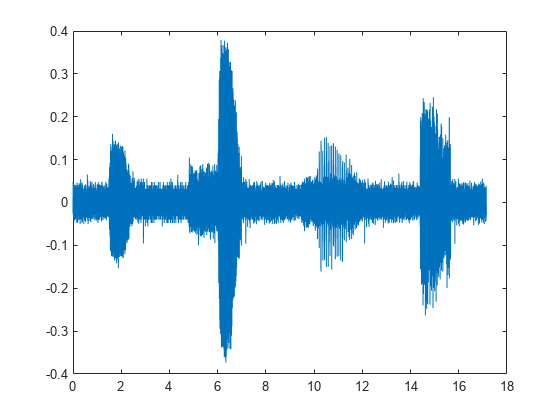addMembers
Add members to labeled signal set
Description
Examples
Load a labeled signal set containing recordings of whale songs.
load whales
lsslss =
labeledSignalSet with properties:
Source: {2×1 cell}
NumMembers: 2
TimeInformation: "sampleRate"
SampleRate: 4000
Labels: [2×3 table]
Description: "Characterize wave song regions"
Use labelDefinitionsHierarchy to see a list of labels and sublabels.
Use setLabelValue to add data to the set.
Retrieve the second member of the set and plot it.
[song,tinfo] = getSignal(lss,2); t = (0:length(song)-1)/tinfo.SampleRate; plot(t,song)

Remove the first and last seconds of the retrieved signal.
song2 = song(t>1 & t<t(end)-1); t2 = (0:length(song2)-1)/tinfo.SampleRate; plot(t2,song2)

Add the shorter signal as a new member of the labeled set.
addMembers(lss,song2) lss
lss =
labeledSignalSet with properties:
Source: {3×1 cell}
NumMembers: 3
TimeInformation: "sampleRate"
SampleRate: 4000
Labels: [3×3 table]
Description: "Characterize wave song regions"
Use labelDefinitionsHierarchy to see a list of labels and sublabels.
Use setLabelValue to add data to the set.
Flip the shorter signal upside-down and add it as a new member of the labeled set. Specify that the new member is sampled at 1 kHz.
addMembers(lss,flipud(song2),1000) lss.SampleRate
ans = 4×1
4000
4000
4000
1000
Input Arguments
Labeled signal set, specified as a labeledSignalSet
object.
Example: labeledSignalSet({randn(100,1)
randn(10,1)},signalLabelDefinition("female"))"female".
Input data source, specified as a matrix, a cell array, a timetable, a signalDatastore object, or an audioDatastore (Audio Toolbox)
object. The particular form of src depends on the Source property of
lss.
If Source is a cell array of matrices:
Specify
srcas a matrix to add one member to the set.Specify
srcas a cell array of matrices to add multiple members to the set.
If Source is a cell array containing cell arrays of vectors:
Specify
srcas a cell array of vectors to add one member to the set.Specify
srcas a cell array containing cell arrays of vectors to add multiple members to the set.
If Source is a cell array of timetables:
Specify
srcas a timetable to add one member to the set.Specify
srcas a cell array of timetables to add multiple members to the set.
If Source is a datastore, then add members by setting
srcas another datastore that points to new files.
Example: {
specifies two members. The first member contains three 10-sample signals. The second
member contains nine 17-sample signals.randn(10,3),randn(17,9)}
Example: {{
specifies two members. The first member contains one 10-sample signal. The second member
contains a 17-sample signal and a 27-sample signal.randn(10,1)},{randn(17,1),randn(27,1)}}
Example: {{
specifies two members. The first member contains three signals sampled at 1 Hz for 10
seconds and two signals sampled at 1 Hz for 7 seconds. The second member contains one
signal sampled at 1 Hz for 3 seconds.timetable(seconds(1:10)',randn(10,3)),timetable(seconds(1:7)',randn(7,2))},{timetable(seconds(1:3)',randn(3,1))}}
Example: signalDatastore Object Pointing to Files
Specify the path to a set of sample sound signals included as MAT files with MATLAB®. Each file contains a signal variable and a sample rate. List the names of the files.
folder = fullfile(matlabroot,"toolbox","matlab","audiovideo"); lst = dir(append(folder,"/*.mat")); nms = {lst(:).name}'
nms = 7×1 cell
{'chirp.mat' }
{'gong.mat' }
{'handel.mat' }
{'laughter.mat'}
{'mtlb.mat' }
{'splat.mat' }
{'train.mat' }
Create a signal datastore that points to the specified folder. Set the sample rate variable name to Fs, which is common to all files. Generate a subset of the datastore that excludes the file mtlb.mat, which differs from the other files in that the signal variable is not called y.
sds = signalDatastore(folder,"SampleRateVariableName","Fs"); sdss = subset(sds,~strcmp(nms,"mtlb.mat"));
Use the subset datastore as the source for a labeledSignalSet object.
lss = labeledSignalSet(sdss)
lss =
labeledSignalSet with properties:
Source: [1×1 signalDatastore]
NumMembers: 6
TimeInformation: "inherent"
Labels: [6×0 table]
Description: ""
Use labelDefinitionsHierarchy to see a list of labels and sublabels.
Use setLabelValue to add data to the set.
Time information for new members, specified as a scalar, a vector, a matrix, a
duration scalar, or a duration vector. This argument is valid only if the TimeInformation property of
lss is 'sampleRate',
'sampleTime', or 'timeValues'.
If TimeInformation is
'sampleRate', thentinfospecifies sample rate values.If TimeInformation is
'sampleTime', thentinfospecifies sample time values.If TimeInformation is
'timeValues', thentinfospecifies time values.
If you add multiple members to a set, then specifying only one value of
tinfo sets the same value for all members. If you want to specify
a different value for each new member, then set tinfo to have
multiple values.
When no source has been specified, or when the labeled signal set source is empty,
you can change the TimeInformation property to
'sampleRate', 'sampleTime', or
'timeValues' to make lss interpret
tinfo correctly.
Example: addMembers(ks,{ adds two new members with different time information to randn(10,5),randn(10,3)},seconds([1
2]))ks =
.labeledSignalSet(randn(10,3),'SampleTime',seconds(1))
Example: addMembers(ks,{randn(10,5),randn(10,3)},[1:10;2:2:20]')ks =
.labeledSignalSet(randn(10,3),'TimeValues',1:10)
Member names, specified as a character vector, a string scalar, a cell array of character vectors, or a string array.
Example: labeledSignalSet({randn(100,1) randn(10,1)},'MemberNames',{'llama'
'alpaca'}) specifies a set of random signals with two members,
'llama' and 'alpaca'.
Version History
Introduced in R2018b
See Also
MATLAB Command
You clicked a link that corresponds to this MATLAB command:
Run the command by entering it in the MATLAB Command Window. Web browsers do not support MATLAB commands.
Select a Web Site
Choose a web site to get translated content where available and see local events and offers. Based on your location, we recommend that you select: .
You can also select a web site from the following list
How to Get Best Site Performance
Select the China site (in Chinese or English) for best site performance. Other MathWorks country sites are not optimized for visits from your location.
Americas
- América Latina (Español)
- Canada (English)
- United States (English)
Europe
- Belgium (English)
- Denmark (English)
- Deutschland (Deutsch)
- España (Español)
- Finland (English)
- France (Français)
- Ireland (English)
- Italia (Italiano)
- Luxembourg (English)
- Netherlands (English)
- Norway (English)
- Österreich (Deutsch)
- Portugal (English)
- Sweden (English)
- Switzerland
- United Kingdom (English)